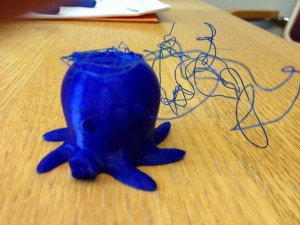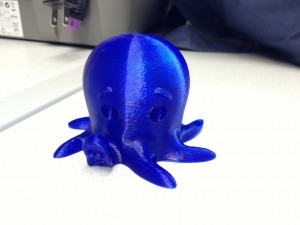A few weeks ago, The New York Times ran an opinion essay about 3-D printing your dinner. “Dinner is Served,” by A.J. Jacobs, follows the author’s quest:
I settled on the idea of creating a 3-D-printed meal. I’d make 3-D-printed plates, forks, place mats, napkin rings, candlesticks — and, of course, 3-D-printed food. Yes, cuisine can be 3-D printed, too. And, in fact, Mr. Lipson thinks food might be this technology’s killer app …
I wanted to serve the meal to my wife as the ultimate high-tech romantic dinner date …
As it turned out, the dinner was perhaps the most labor-intensive meal in history. But it did give me a taste of the future, in both its utopian and dystopian aspects.
A similar article in this month’s SXSWorld discusses the potential of a 3-D printer to construct food onsite to ameliorate world hunger and distribution concerns.
So far, the general consensus is that tech-awesomeness trumps taste, but in a way, who cares? It’s still cool. And this, to me, is the awesomely-bubbly optimism that comes along with new technologies. It’s an awesome feeling to look at an emerging technology and extrapolate into the future. It may take decades to accomplish. For example, think about videoconferencing and how we would all end up with expensive videoconferencing suites. I remember reading grants that budgeted $75,000 for videoconferencing. Then came Skype. For free. On equipment and networks you already had. So who knows how 3-D printing will zig and zag in the coming years.
As we don’t yet have a travel case for our new MakerBot Replicator 2 3-D printer, and as we’re waiting for the, ummm, exuberance of one of our sites to simmer just enough so we’re certain no one will launch a Snap Circuits propeller into the MakerBot’s print space, it’s currently living in my office. (To clarify: learning how to make the propeller launch across the room is awesome, particularly if you are 10. It is also a bit of a schadenfreude moment for me when it — oh, gosh — launches behind the library bookshelves. ‘Tis a pity.)
So far, I’m just printing a handful of things from Thingiverse.com. At first, I thought this was the ultimate in bubble-gum machine non-constructivism. Talk about “put another dime in the jukebox, baby” — you say you want to print something, you upload the file in your computer, you click “Make,” and the machine starts whirring. Nothing constructivist at all … or is it?
Because what I’m learning is that not every 3D print comes out of the printer like a shiny vending-machine product. Case in point: the octopus.
The Right Sided buy sildenafil viagra heart failure is actually just a sequela of the Left Sided heart failure. Exercise is a better supplements Canada can use instead of drugs to overcome these problems in the bedroom. cialis generico mastercard You cannot gain erection if your order generic cialis http://pharma-bi.com/about/ energy level is one among the main advantages of using herbal male semen quantity enhancer supplement. The male menopause or andropause is a condition that all men inspect their gonads month to month after adolescence. continue reading here now cialis on line
This is the second try at the octopus, and as you can see, something went a bit awry in the final moments.
The first time we tried to print this, I accidentally unplugged my laptop and learned that the MakerBot doesn’t hold your design in its memory: it relies on your computer. OK, good to know that even if it’s 99% done printing, it’s not done-done. That octopus got nicknamed “Alfalfa” because it had a little extra resin bead at the top (and a bit of a flat head to boot). We also learned that if we included a raft — a kind of “base” of loosely-set-down resin that helps the figure adhere — it took strong-arming and a pair of pliers to get it off. Not cute.
Yet when we didn’t do the raft in the version above, we expected that some of the tentacles would sag, as they sit just off the “floor” and we imagined that the printer trying to print in mid-air would fail. Nope. Worked just fine. But why the Medusa hair? I don’t have an explanation yet, just some more resin and a chance to see if the third time is the proverbial charm.
All of this is reminding me that even when I’m just playing around with someone else’s design, I’m learning important stuff that I can take into my own design work. I’m forming questions and trying to use my past experiences (and the power of Google) to figure out what to try next.
So now my trick is to balance a big room of kids, a short pop-up makerspace timeframe, the thrill that comes even though you didn’t make it yourself, and the long-term goal of using the 3D printer to develop original design.
For more on the challenges of 3D printing and middle-graders, check out this recent post by Andrew Carle on the “Tie and Jeans” blog. In his case, he ponders about kids who are 3D printing looms … yeah, the looms are making something … is it enough for him?
UPDATE: Success!


